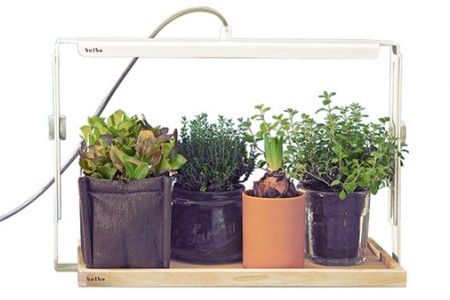Feeding the City
It is anticipated that global populations living in urban areas is going to “increase by 84 per cent by 2050, from 3.4 billion in 2009 to 6.3 billion in 2050.” (United Nations, 2009). Indeed, since 2009, the population living in urban areas had surpassed the number living in rural areas. There is therefore the inevitable question of how these mega-cities of the future can sustainably feed these populations. In this article, I have decided to investigate how different designers and architectural practices have attempted to resolve this issue at a variety of household, communal and urban scales.
Beginning at the smallest scale is a series of side table micro-gardens, designed by Conceptual Devices. With a modular system of 65X95cm combining Ikea’s plastic trays with special LED lights, this system can grow “24 plants at once [while] consuming less than 50 watts.” (Conceptual Devices, 2014). For me, these small scale plans offer individual existing homes with the opportunity to reduce its shopping needs, growing their own basic vegetables in a private micro-garden.
At the next scale up, we have the communal garden, an alternative system designed by Studio Segers. Complete with a chicken coop, this modular system involves a mini-outdoor greenhouse, combining systems of composting and rainwater collection with vegetable growth (DesignBoom, 2014). As a result, this alternative has hopes of encouraging local community ties (DesignBoom, 2014), with each individual farm providing different foods and animals and thus, allowing city farming to provide source of incomes at local agricultural markets.
Drastic Changes - New Urban Farming Towers, offers up the solution of inner city farming at a dense and industrial scale,
solving the crisis of food shortage. (WebUrbanist, 2014).
Despite the innovation of these minor interventions into our existing urban fabrics for city farming, others have argued that the additional 3 billion people anticipated in our cities over the next forty years cannot simply be resolved with minor interventions. Given that 80% of our existing agricultural land is already in use, and 15% is expected to be too polluted (TreeHugger, 2005), more drastic urban scale designs have also been proposed to resolve the increasingly real problem of starvation. Alongside Columbia University, a series of urban farming towers have been proposed, “all-in-one eco-towers…produce more energy, water and food than their occupants would consume.” (WebUrbanist, 2014). These towers would create larger communities of gardening, separate from our existing urban fabric, but close enough that cities can become independent of rural farms.
Symbiotic Interlock - Modular structures with two goals - keeping our aging buildings stable, and making them more ecologically sustainable, simultaneously. (WebUrbanist, 2014).
Finally, we reach the most drastic new interventions, integrated urban habitats with sky gardens and recreational spaces. For older deteriorating structures, these modular systems have become a potential structural solution to age, providing gardening, but also structural stability (WebUrbanist, 2014). Arguably the most interventional, it nonetheless for me provides exiting opportunities of reuse and adaptation, converting our aging city fabric with the individual independence of personal gardens and communal city farms.
Since the development and success of New York’s Highline, vertical gardens and sky parks have become fashionable and desirable. It is certainly my firm belief that as our cities urbanise, our office skyscrapers will grow alongside agricultural skyscrapers, allowing communities to become more self-sufficient and operate locally rather than relying on international imports and rural farming. As we enter the brave new world of urbanisation and increased densification, our cities will also need to evolve and adapt to meet the needs of our increasing number of stomachs.
References
DesignBoom. “Studio Segers Enables City Farming with Daily Needs Unit.” (26 January 2014). Retrieved 23 May 2014 from: http://www.designboom.com/design/studio-segers-enables-city-farming-with-daily-needs-unit-01-25-2014/
Conceptual Devices. “Orto Perpetuo. A Year Round Edible Garden in Your Apartment.” (2014). Retrieved 23 May 2014 from: http://www.conceptualdevices.com/2014/04/orto-perpetuo-a-year-round-eadible-garden-in-your-apartment-urban-agriculture-survival-kit-salone-del-mobile-milano-2014/
TreeHugger. “Vertical Farming – The Future of Agriculture?” (27 June 2005). Retrieved 23 May 2014 from:
http://origin.www.treehugger.com/sustainable-agriculture/vertical-farming-a-the-future-of-agriculture.html
WebUrbanist. “3D City Farms: 5 Urban Design Proposals for Green Towers.” (2014). Retrieved 23 May 2014 from; http://weburbanist.com/2008/03/30/5-urban-design-proposals-for-3d-city-farms-sustainable-ecological-and-agricultural-skyscrapers/
United Nations Department of Economic and Social Affairs. “Population Division – Urban and Rural Areas 2009.” (2009). Retrieved 23 May 2014 from: http://www.un.org/en/development/desa/population/publications/urbanization/urban-rural.shtml








